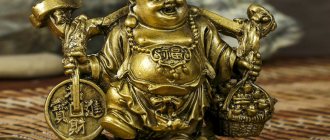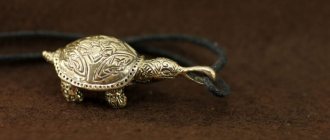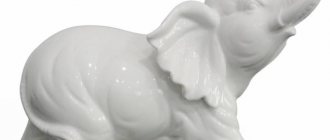| A long-wadied wading bird, the symbolic meaning of which is influenced by its long beak, tirelessness in flight (long-distance seasonal flights), organization of the flock, and caution (the bird's eyes have a 360-degree view). In ancient images it is often confusingly similar to a stork or a heron, from which it can be distinguished by its typical pose - with a stone raised with a stone clutched in its claws. This feature of the image goes back to legendary information, according to which, “every night the cranes gather around their king. Certain cranes are chosen as guardians, and they must stay awake all night, fighting off sleep with all their might. Therefore, each guardian crane stands on one leg, raising the other. He holds a stone in his raised paw. If a crane falls asleep, a stone will fall out of its paw and, falling on the paw on which it stands, will wake it up.” Like other birds standing in the water (ibis, stork, heron), the crane is one of the embodiments of the light of the morning sun, since it is the first to see its rise. As an intermediary between worlds, the crane acts as a messenger from God and a conductor (carrier) of the souls of the dead to the place of their afterlife. Thanks to its long beak and mating dances, the crane in many traditions acts as a phallic symbol, as well as a messenger of fertility, bringing rain. Mediterranean cultures are characterized by the erotic “crane dance”. The use of the crane as an allegory of justice, longevity, righteousness and a merciful soul is very widespread (from Mediterranean cultures to China). The crane also attracts attention as a snake fighter. Basic values:
|
Content
- 1 Basic values:
- 2 Egypt
- 3 Antiquity
- 4 Northern tradition
- 5 China
- 6 Japan
- 7 Indochina
- 8 Hinduism
- 9 Buddhism
- 10 Bible/Old Testament
- 11 Christianity
- 12 Magic
- 13 Fortune telling
- 14 Heraldry
- 15 Emblems
- 16 Psychology
- 17 Art
- 18 ad vocem
- 19 Illustrations
- 20 Notes and comments
See also:
Birds Stork Heron Ibis Vigilance
Symbol in Russia
Sometimes it seems to me that the soldiers
Those who did not come from the bloody fields,
They once did not perish in this earth,
And they turned into white cranes...
The song by Ian Frenkel to the verses of Rasul Gamzatov (translated by Naum Grebnev) best reflects the attitude towards the image of the crane in Russia. This is a sign of the mother, father's home, Motherland and land. The crane is an image that carries within itself a bright, aching sadness and warmth. As a heavenly messenger, this bird takes the souls of the dead on their final journey, and as a messenger of life, it escorts babies to their homes. This attitude to the image once again tells us that since ancient times the way of life and death has been inextricably linked and one is inseparable from the other.
Antiquity
For the ancient Greeks, the arrival of cranes and their screeching was a signal for the beginning of sowing, and then the harvest.
Attribute (dedicated):
- Apollo - like a bird of light, the messenger of spring.
- Hermes - as a tireless traveler (wanderer);
- Demeters;
- Artemis;
- Athens Pallas, Athens-Hera;
- Perseus.
The famous crane dance geranikos - the embodiment of cheerfulness and love, is based on the movement of cranes during the current and is associated with the cult of Athena-Hera[2]. Later it is reinterpreted as the dance of the Sun, and its occurrence is associated with the joyful dance of Theseus and his companions emerging from the Labyrinth. This explains the circular movements of the “crane” dancers around the altar decorated with horns, reproducing the curves of the Cretan Labyrinth or labyrinth where the initiation ceremony took place.
Persistent ancient themes associated with cranes include:
- the enmity of cranes with pygmies living in the south of Egypt and Ethiopia[3].
“The cranes, screeching so loudly, fly up into the endless sky, escaping the hardships of winter... On their wings they carry away ruin and death for the pygmies.” "Iliad" by Homer.
- cranes Ibicus (Ibicus) - a school of cranes became the only witness to the murder of the Greek poet and singer Ibicus (the killers gave themselves away when at the market one of them, looking at the sky, exclaimed: “Cranes of Ibicus!”).
- The crane's stinginess is a fable about a stingy owner, first found in Aesop's story about the crane and the fox.
Legends about the origin of the Greek alphabet are associated with the Crane Wedge. It is believed that the outline of a crane wedge flying in the sky served as the basis for drawing the letters with which Palamedes (according to another version - Hermes) supplemented the alphabet invented by King Cadmus. Thanks to this (?), the crane often acts as a companion (patron) of poets and serves as one of the symbols of dedication.
To strengthen marital bonds
The crane, like the popular mandarin ducks, is a symbol of marriage and romance. These birds are monogamous and live with one partner all their lives. Therefore, the crane is associated with harmony and peace in the family.
Although the bird will probably not bring romantic luck in love, like the mandarin duck, it helps strengthen family ties and procreation. Therefore, crowned white cranes with red crowns are a suitable gift for the head of the family, for example, for an anniversary and birthday.
China
Crane (ho, he) - “Patriarch of the Feathered Tribe”, messenger of the gods, mediator between heaven and earth, endowed with many positive properties and meanings. It is believed that from the inside this bird is absolute Yang, devoid of the principle of death.
Snow-white cranes are holy birds that inhabit the Isles of the Blessed. The color of their plumage serves as a symbol of purity, and the cinnabar-colored head is an indication that he knows how to retain vitality within himself. The Immortals of the Taoist tradition and the souls of the dead fly in the skies on cranes, heading to the Western Taoist paradise. The death of Taoist priests is described with the words "yu-hua", which suggests their transformation into cranes.
The black crane, according to popular belief, can live up to a thousand years, partly due to the ability to breathe with a bent neck; This technique, which softens the breath, is practiced by Taoists.
The bending neck of a crane is also considered a sign (symbol) of wisdom - offensive and vain words linger in its bends, giving time to think and prepare a balanced answer.
The crane often appears in fine art as an image of long life, most often as part of a "triple symbol of longevity" including crane, pine and stone. The latter can sometimes be replaced by cypress.
Together with the phoenix, heron, duck and wagtail, it is part of a group of birds representing five types of relationships between people - it embodies a model of the relationship between father and son (the crane chick responds to the cry of its parents).
The crane rising to the Sun expresses the desire for social advancement and serves as a symbol of prosperity and high official position.
Place the Sun at home
In ancient mythology, the crane became the companion of Apollo, the patron of the arts. Therefore, it makes sense for people of creative professions to put a figurine of a crane on their desktop. With Hermes, the messenger of the gods, a tireless traveler between worlds, the crane shares the power of its wings, supporting the god when his strength leaves him. If you want to fly high and achieve your goals, the crane will help you. Well, the crane helps the goddess of fertility Demeter to give people a rich harvest. Place a garden sculpture of a crane on your summer cottage - you will not know grief.
Emblematics
Sensitivity, observation. If something alarms the crane, it gives a signal by screaming or screeching; in order not to fall asleep, he stands on one leg and holds a stone in the toes of the other. This gave the bird a reputation as a stupid creature, a dullard.
“The crane at night prudently holds a pebble in its claws so as not to fall asleep by accident. So, when we trust the world too much and too easily, Time again reminds us of our righteous duty.” Hochberg.
Attribute:
- personified Vigilance - with a stone in its paw;
- ~ Melancholy - shot.
As a symbol of silence, it is depicted with a white cane in its beak.
A crane lifting a stone with its paw.
- It's hard to take me by surprise.
“Observations by naturalists have shown ... the crane, due to its fear of the unexpected, always sleeps with a stone in its paw so as not to fall too deeply asleep.”
EMSI 18-12, p.179 A crane with sand pouring out of its beak.
- Speak only at the appropriate time and in the appropriate place.
Symbol of silence: we must be careful what we say, where we say it, when we say it, and to whom we say it.
Another image of forethought attributed to the crane. “By filling its beak with sand and carelessly pouring it out, it makes noise and thereby gives itself away.” EMSI 18-13, p.179 Crane eating snakes.
- By pleasing my stomach, I benefit my country.
Symbol of patriotism.
“They say that there is an innate antipathy between cranes and snakes. Cranes find snake holes and eat their inhabitants, thereby clearing the area in which they live of snakes. In Egypt and Thessaly, where many snakes lived, killing a crane... was punishable by death. In addition, cranes are well tamed and value human company - they are accustomed to building their nests near his home. They claim, although this is not confirmed by facts, that they have a special love for countries with a republican system of government. They have many other very valuable qualities and are one of the rare examples of extraordinary filial love.” EMSI 55-4, p.338 Crane swallowing a snake.
- It's a shame I can't destroy them all.
The symbol of a kind, merciful person, focused on doing good deeds, and determined to do as many good deeds as he can.
EMSI 58-15, p.351 A crane holding a stone in its paw.
- Be vigilant.
A symbol of vigilance, especially for the clergy.
“It shows that the clergy should not indulge in idleness and excessive sleep. For he who has taken upon himself the high responsibilities of directing the lives of others must be very vigilant to ensure that he himself does not stray from the right path. ... we should all learn to be constantly on guard, since we are all, to some extent, guardians.” EMSI 29-4, p.223 Crane with a stone in its beak.
- Restrain yourself.
A symbol of prudent restraint. “Cranes keep a stone in their beaks so as not to make unnecessary noise and prevent themselves from being detected. In this way, cranes escaped from eagles in the area of Mount Taurus.” EMSI 29-2, p.223
about the author
The poet was born in September 1923 in the village of Tsada, located in Dagestan. Poet and laureate of the State Prize of the Soviet Union.
He graduated from the Araninsk school and the Avar pedagogical school. Upon graduation, he worked as a teacher, then as an assistant director, as a staff reporter for the Bolshevik Gor newspaper, and as an editor at the Dagestan Radio Committee. In 1945 he began studying at the Institute named after. Maxim Gorky in Moscow. Since 1951, Rasul Gamzatovich served as chairman of the Writers' Union of Dagestan. He remained in this position until the end of his life. Gamzatov began his creative journey at the age of nine. Very early his poems found their way into newspapers and magazines. The first collection of poems was published in 1943 in the Avar language. Many of his works later became songs.
Rasul Gamzatovich has many government awards, titles and prizes. His name is widely known outside of Russia and the CIS countries. The writer died in 2003 and was buried near Mount Tarki-Tau, next to his wife’s grave.
Crane in the Bible and Christianity
The crane acts as a bird endowed with the gift of hearing the divine will and obeying it. Thus personifying piety and love of God.
“And the stork under the sky knows its appointed times, and the turtledove, and the swallow, and the crane watch the time when they should fly, but my people do not know the decree of the Lord.”
The crane also acts as a bearer of traits inherent in a humble monastic life. Namely, religiosity and obedience - birds travel behind the leader. At the same time, they personify purity of thoughts, devotion, asceticism of life and order.
Image of a crane in Japan
In Japan, the crane occupies one of the central places among revered birds and animals. It symbolizes nobility, wisdom and justice - one of the main spiritual qualities in the country's culture.
“Tsuru” is the Japanese name for a crane, and “tsurukame” means a wish for a long life. Indeed, in Japan the bird symbolizes longevity and prosperity.
The crane symbol is found in almost all forms of art. We find the image on household items, vases, panels, paintings, commemorative stamps.
The most famous Japanese fairy tale legend says that a young man saved a wounded girl, and she married him. The girl turned out to be an excellent weaver and wove wonderful fabrics from her feathers. But when her husband spied on her, she turned into a crane and flew away. More than one performance has been staged based on this legend.
Another legend associated with reincarnation says that cranes take the form of a wandering monk. In this guise they seek help and reward those who are pure in heart and soul. This is a popular image, the analogue of which in Russian culture is an old beggar woman who turns out to be a powerful witch. Thus, the crane is a symbol of purity, help, sincerity and selflessness.
When people talk about the art of origami, cranes and the Japanese girl Sadako Sasaki immediately come to mind. Alas, this image has nothing to do with legends and is based on absolutely real events. Sadako died at age 14 from radiation sickness, like many victims of the Hiroshima bombing. But this girl’s name is associated with dreams, perseverance and the desire to live. In Japan, there is a belief that if you fold a thousand sembazuru cranes out of paper, any wish will come true and any illness will disappear. The girl did not have time to make the required amount and died, holding her 643 crane in her hands. The remaining 357 were made by children from her class. It was this story that became the prototype for the monument to those killed in the nuclear disaster in Japan. And to this day, when schoolchildren come to the monument, they leave pre-prepared cranes.
Unlike Slavic culture, in Japan there was no strict ban on killing cranes. But the hunt had to be fair and was purely ceremonial in nature. No more than one or two birds were killed and presented to the emperor’s table as a wish for a long life.
The rest of the time, the cranes were cared for and protected.
The crane is loved in many cultures
Crane in Chinese mythology
In China, the crane was called “he” and was associated with Yang, that is, it reflected the bright beginning. And it is considered one of the symbols of eternal life (there are 10 of them in the culture). The metamorphoses attributed to he are interesting.
In the mythological understanding, up to 160 years of age, he feeds on the energy of fire, and by this age his plumage becomes the purest white color; it is precisely after reaching the 160th anniversary that the bird can speak with the sky. Having lived up to a thousand years, the white crane changes its plumage to gray-green, and at the age of two thousand it acquires a jet-black color. There is a belief that the white crane is a skillful and graceful dancer, while the black crane is able to capture the slightest shades of a musical composition and has a keen ear.
The crane was not left without divine attention; very often it is depicted together with the god of happiness Fu-hsin. In the ancient book of history (Shang Fu), happiness is designated as a reflection of the basic five principles: peace, health, wealth, virtue and longevity.
The crane is also closely associated with the so-called “eight immortals”. One of these heroes had a crane's neck, and at the moment of his birth this majestic bird descended to earth.
The second immortal was named Zhongli Quan, and he flew on the back of a crane to the land of immortals, according to the instructions found in the jade box.
But the crane took Lan Tsai-he away in the middle of a stormy day.
The fact that immortality is one of the signs of the crane symbol in Chinese mythology, we also see in the description of the death of an enlightened hermit. In China, these are two words yu-hua, which means “turning into a crane.”
We see images of cranes in China as often as in Japan. Paintings depicting these birds have a symbolic meaning, and they are given as souvenirs with wishes for longevity. A canvas depicting a pair of cranes symbolizes strong marriage ties and a happy family.
The ruling dynasties did not ignore the cranes. Their images appear in Shang tombs and ceremonial bronzes of the Zhou dynasty.
A distinctive feature of a crane in strange images is a raised leg with a stone clutched in its claws. There is a legend associated with this image that every night the cranes gather in a circle near their king. In order to protect his peace, they choose their own sentries. They must with all their might drive away the incoming sleep in order to remain a vigilant guard. Therefore, the sentry raises his paw and takes a stone in it; if he suddenly falls asleep, the stone will fall out of his claws and hit the second leg, thereby waking up the bird.
Because of its exceptional importance to Chinese culture, the crane has been selected by the National Forestry Bureau as a candidate for the title of national animal of China.
In Christianity, the crane was also considered a positive hero











